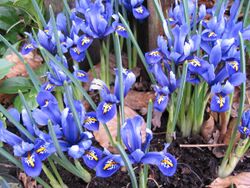Biology:Iris subg. Hermodactyloides
| Iris subg. Hermodactyloides | |
|---|---|

| |
| Iris reticulata | |
| Scientific classification | |
| Kingdom: | Plantae |
| Clade: | Tracheophytes |
| Clade: | Angiosperms |
| Clade: | Monocots |
| Order: | Asparagales |
| Family: | Iridaceae |
| Genus: | Iris |
| Subgenus: | Iris subg. Hermodactyloides |
| Series | |
|
See text | |
The subgenus Hermodactyloides of Iris includes all reticulate-bulbed bulbous irises. It was formerly named as a genus, Iridodictyum by Rodionenko in 1961.[1][2][3] but it was not widely accepted and most botanists preferred 'Hermodactyloides'.
Édouard Spach named the genus in 1846.[4] The word 'Hermodactyloides' comes from 'Hermes' , a Greek God, and 'daktylos' - finger. The name for the subgenus is very similar to Hermodactylus (the former name for Iris tuberosa), which was originally a separate genus to irises, but in 2001 was re-classified to be within the Hermodactyloides sub-genus.[5]
Most species are native to central Europe and central Asia. They mostly have one or two long leaves and flower in early spring.
Taxonomy
The subgenus Hermodactyloides is subdivided into two sections; Reticulatae and Monolepsis.[6] Known species include:[7]
Section Reticulatae
|
Section Monolepsis
Originally Rodionenko created the genus Alatavia for Iris kolpakowskiana and I. winkleri, but it was not validly published.[8][9] B.Mathew then changed the name in 1989 to Iris sect. Monolepsis, after his re-organization of the genus.[10] Molecular evidence places Monolepis as sister to a clade including section Reticulatae (including Hermodactylus), subgenus Xiphium and subsection Syriacae of section Limniris.[11]
Having flattened crocus-like leaves;
|
Cultivation
This genus of dwarf bulbous iris is mostly used in rock gardens, or planted by specialist collectors in bulb frames.
References
- ↑ "Iridodictyum Rodion". efloras.org. http://www.efloras.org/florataxon.aspx?flora_id=120&taxon_id=314138.
- ↑ "Genus: Iridodictyum Rodion.". ars-grin.gov. http://www.ars-grin.gov/cgi-bin/npgs/html/genus.pl?18087.
- ↑ "Iridaceae Iridodictyum Rodion.". ipni.org (International Plant Names Index). http://www.ipni.org/ipni/idPlantNameSearch.do?id=20382-1.
- ↑ Spach, Edouard (1846). "Histoire naturelle des végétaux. Phanérogames". bibdigital.rjb.csic.es. p. 91. http://bibdigital.rjb.csic.es/ing/Carga.php?Pagina=P0044_S3_05/P0044_S3_05_0091.pdf.
- ↑ Tillie N, Chase MW, Hall T. 2002 Molecular studies in the genus Iris L.: a preliminary study. Ann. Bot. n.s. (Italy) 1. (2): 105-112 (2001)
- ↑ Cassidy, G.E.; Linnegar, S. (1987). Growing Irises (Revised ed.). Bromley: Christopher Helm. pp. 144–145. ISBN 0-88192-089-4.
- ↑ "Species Records of Iris subg. Hermodactyloides". Germplasm Resources Information Network (United States Department of Agriculture). http://www.ars-grin.gov/cgi-bin/npgs/html/splist.pl?19547.
- ↑ "Canadian Iris Society cis newsletter Winter 2013, Volume 57, Issue 1". www.e-clipse.ca. 2013. http://www.e-clipse.ca/previews/CIS/C-V57N1_hi-rez.pdf.
- ↑ "International Plant Names Index". http://www.ipni.org/ipni/advPlantNameSearch.do?find_family=&find_genus=Alatavia&find_species=&find_infrafamily=&find_infragenus=&find_infraspecies=&find_authorAbbrev=&find_includePublicationAuthors=on&find_includePublicationAuthors=off&find_includeBasionymAuthors=on&find_includeBasionymAuthors=off&find_publicationTitle=&find_isAPNIRecord=on&find_isAPNIRecord=false&find_isGCIRecord=on&find_isGCIRecord=false&find_isIKRecord=on&find_isIKRecord=false&find_rankToReturn=all&output_format=normal&find_sortByFamily=on&find_sortByFamily=off&query_type=by_query&back_page=plantsearch.
- ↑ Rina Kamenetsky and Hiroshi Okubo Ornamental Geophytes: From Basic Science to Sustainable Production, p. 24, at Google Books
- ↑ Carol A. Wilson. Subgeneric classification in Iris re-examined using chloroplast sequence data. 2011. Taxon. 60(1): 27-35.
Wikidata ☰ Q18349260 entry
 |

